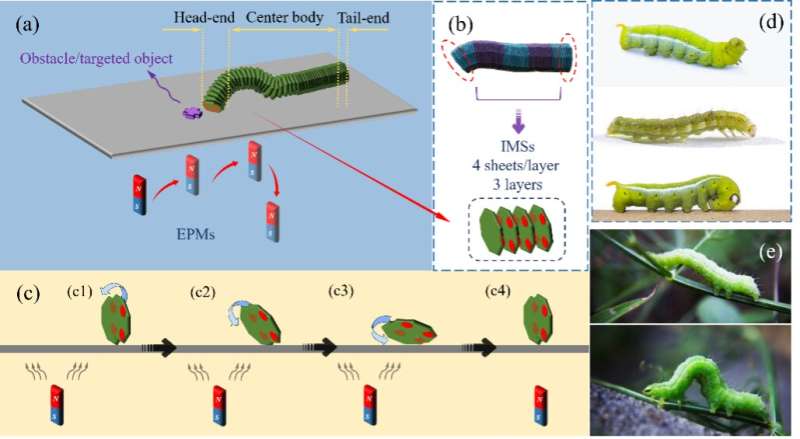Bio-inspired robots, robotic systems that emulate the appearance, movements, and/or functions of specific biological systems, could help to tackle real-world problems more efficiently and reliably. Over the past two decades, roboticists have introduced a growing number of these robots, some of which draw inspiration from fruit flies, worms, and other small organisms.
Researchers at China University of Petroleum (East China) recently developed a worm-inspired robot with a body structure that is based on the oriental paper-folding art of origami. This robotic system, introduced in Bioinspiration & Biomimetics, is based on actuators that respond to magnetic forces, compressing and bending its body to replicate the movements of worms.
“Soft robotics is a promising field that our research group has been paying a lot of attention to,” Jianlin Liu, one of the researchers who developed the robot, told Tech Xplore. “While reviewing the existing research literature in the field, we found that bionic robots, such as worm-inspired robots, was a topic worth exploring. We thus set out to fabricate a worm-like origami robot based on the existing literatures. After designing and reviewing several different structures, we chose to focus on a specific knitting pattern for our robot.”
The worm-inspired robot created by Liu and his colleagues consists of an origami-based backbone, 24 magnetic sheets inside its body, and two NdFeB magnets in the external part of its body. The robot’s backbone was created following a paper-knitting origami pattern.

When exposed to magnetic forces, the robot’s body deforms and compresses, resulting in locomotion patterns that resemble those of earthworms and other crawling, worm-like organisms. As it is primarily based on paper and magnets, the system is low-cost, easy to fabricate and weighs very little.
“The origami structure proposed in this article reproduces the both appearance and structure of worms and other worm-like creatures,” Liu explained. “Several robots introduced in recent years are based on magnetic actuation, and these robots can be valuable for different applications, for instance for cleaning pipelines and other constricted environments. Our work could largely enrich the origami robot field and inspire the development on new advanced equipment.”
In initial simulations, the researchers used their robot to produce three different types of motion, which they dubbed the inchworm, Omega and hybrid motions. These different locomotion styles could allow a more advanced version of their robot to effectively tackle different types of tasks, for instance avoiding obstacles, climbing walls, crawling inside pipes, or delivering small parcels.

In the future, Liu and his colleagues plan to further improve their robot’s design and create more advanced bio-inspired robotic systems. In addition, they hope that their work will inspire other research teams to create similar worm-inspired robots that could help to solve a wide range of real-world problems more efficiently.
“The development of origami robots based on bionic worms is a promising research topic and I plan to explore it further in my future work,” Liu added. “For example, I would like to design more origami prototype robots with features that are specifically inspired by earthworms or other worms, which could be valuable for specific applications. Finally, focusing on other actuation methods could also potentially enrich our research.”
More information:
Yuchen Jin et al, A worm-inspired robot based on origami structures driven by the magnetic field, Bioinspiration & Biomimetics (2023). DOI: 10.1088/1748-3190/acd59e
© 2023 Science X Network
Citation:
A worm-inspired robot based on an origami structure and magnetic actuators (2023, May 29)
retrieved 29 May 2023
from https://techxplore.com/news/2023-05-worm-inspired-robot-based-origami-magnetic.html
This document is subject to copyright. Apart from any fair dealing for the purpose of private study or research, no
part may be reproduced without the written permission. The content is provided for information purposes only.

